Evaluation of the Growth, Sporulation, Fungicide Efficacy, and Host Range of Ramularia sphaeroidea
Abstract
:1. Introduction
2. Materials and Methods
2.1. Isolation of the Fungus
2.2. Multigene Sequencing
2.3. Growth, Sporulation, and Germination of R. sphaeroidea
2.3.1. Culture Media
2.3.2. Carbon and Nitrogen Media
2.3.3. Effects of Temperature on Conidial Germination
2.4. Phylogenetic Analysis
2.5. Pathogenicity and Host Range
2.6. Fungicide Sensitivity Experiments
3. Results
3.1. Phylogenetic Analysis
3.2. Symptoms, Pathogen Isolation, and Conidia Germination
3.3. Growth, Sporulation, and Germination of R. sphaeroidea
3.3.1. Culture Media
3.3.2. Carbon Sources
3.3.3. Nitrogen Sources
3.3.4. Effects of Temperature on Conidial Germination
3.4. Pathogenicity and Host Ranges
3.5. Fungicide Sensitivity Test
4. Discussion
5. Conclusions
Supplementary Materials
Author Contributions
Funding
Institutional Review Board Statement
Informed Consent Statement
Data Availability Statement
Conflicts of Interest
References
- Chen, G.X.; He, P.; Ao, X.C.; Liu, Q. Biological characters of Liangshan shiny leaf purple flower vetch (Vicia villosa) and analysis of affecting factors for its seed and forage production. Pratacultural Sci. 2006, 23, 30–34. [Google Scholar] [CrossRef]
- Kissing Kucek, L.; Riday, H.; Rufener, B.P.; Burke, A.N.; Wiering, N.P. Pod Dehiscence in hairy vetch (Vicia villosa Roth). Front. Plant Sci. 2020, 11, 82. [Google Scholar] [CrossRef] [PubMed]
- Xia, X.L.; Tang, L.L.; Xiong, J.L.; Han, Y.; Zhang, Y.R.; Long, M.; Yang, Q.G.; Jao, Y.X. The study on the nutrition and feeding value of smooth vetch. Pratacultural Sci. 2005, 22, 52–56. [Google Scholar]
- Liu, P.; Wang, Y.R.; Liu, Z.P. Karyotypes analysis of 43 Vicia accessions. Pratacultural Sci. 2015, 32, 908–926. [Google Scholar]
- Renzi, J.P.; Chantre, G.R.; Smykal, P.; Presotto, A.D.; Zubiaga, L.; Garayalde, A.F.; Cantamutto, M.A. Diversity of naturalized hairy vetch (Vicia villosa Roth) populations in central argentina as a source of potential adaptive traits for breeding. Front. Plant Sci. 2020, 11, 189. [Google Scholar] [CrossRef]
- Pouryousef, M.; Alizadeh, K. Forage yield improvement at proper ratio and seed density of smooth vetch and barley mix cropping under cold rain-fed conditions. Legume Res. 2014, 37, 402. [Google Scholar] [CrossRef]
- Pramanik, P.; Haque, M.M.; Kim, P.J. Effect of nodule formation in roots of hairy vetch (Vicia villosa) on methane and nitrous oxide emissions during succeeding rice cultivation. Agric. Ecosyst. Environ. 2013, 178, 51–56. [Google Scholar] [CrossRef]
- Wang, T.J.; Lu, Z.Z.; Chen, G. Determination on growth and grazing tolerance of the new strain of Vicia villosa Roth var. glabrescens cv. Liangshan in winter. China Herbiv. Sci. 2013, 33, 34–36. [Google Scholar]
- Gu, L.J.; Duan, T.Y. Current status of research on Vicia villosa var. glabresens as indicated by a bibliometric analysis using the China National Knowledge Infrastructure (CNKI) database. Acta Prataculturae Sin. 2021, 30, 221–228. [Google Scholar]
- Abawi, G.S.; Ludwig, J.W. Host efficiency of 16 cover crops to the lesion nematode. Phytopathology 1995, 1, 1554–1555. [Google Scholar]
- Abawi, G.S.; Widmer, T.L. Impact of soil health management practices on soilborne pathogens, nematodes and root diseases of vegetable crops. Appl. Soil Ecol. 2000, 15, 37–47. [Google Scholar] [CrossRef]
- Sahile, S.; Ahmed, S.; Fininsa, C.; Abang, M.M.; Sakhuja, P.K. Survey of chocolate spot (Botrytis fabae) disease of faba bean (Vicia faba L.) and assessment of factors influencing disease epidemics in Northern Ethiopia. Crop J. 2008, 27, 1457–1463. [Google Scholar] [CrossRef]
- Devi, S.I.; Talukdar, N.C.; Sharma, K.C.; Jeyaram, K.; Rohinikumar, M. Screening of Rhizobacteria for their plant growth promotion ability and antagonism againstdamping off and root rot diseases of broad bean (Vicia faba L.). Indian J. Microbiol. 2011, 51, 14–21. [Google Scholar] [CrossRef] [PubMed]
- Koike, S.T.; Smith, R.F.; Crous, P.W.; Groenewald, J.Z. Leaf and stem spot caused by Ramularia sphaeroidea on purple and lana woollypod vetch (Vicia spp.) cover crops in California. Plant Dis. 2004, 88, 221. [Google Scholar] [CrossRef] [PubMed]
- Nan, Z.B.; Li, C.J. List of forage fungal diseases in China. Lanzhou. Pratacultural Sci. 1994, 11, 36–37. [Google Scholar]
- Videira, S.; Groenewald, J.Z.; Braun, U.; Shin, H.D.; Crous, P.W. All that glitters is not Ramularia. Study Mycol. 2016, 83, 49–163. [Google Scholar] [CrossRef]
- Kaczmarek, M.; Piotrowska, M.J.; Fountaine, J.M.; Gorniak, K.; Grann, G.R.D.; Armstrong, A.; Havis, N.D. Infection strategy of Ramularia collo-cygni and development of ramularia leaf spot on barley and alternative graminaceous hosts. Plant Pathol. 2017, 66, 45–55. [Google Scholar] [CrossRef]
- Walters, D.R.; Havis, N.D.; Oxley, S.J.P. Ramularia collo-cygni: The biology of an emerging pathogen of barley. FEMS Microbiol. Lett. 2008, 279, 1–7. [Google Scholar] [CrossRef]
- Cromey, M.G.; Harvey, I.C.; Sheridan, J.E.; Grbavac, N. Occurrence, importance and control of Ramularia collo-cygni in New Zealand. In Proceedings of the Second International Workshop Barley Leaf Blights, Aleppo, Syria, 7–11 April 2002; pp. 7–11. [Google Scholar]
- Nyman, M.; Havis, N.D.; Oxley, S.J.P. Importance of seed-borne infection of Ramularia Collo-Cygni. Asp. Appl. Biol. 2009, 92, 91–96. [Google Scholar]
- Braun, U. A monograph of Cercosporella, Ramularia and allied genera (phytopathogenic hyphomycetes). Cryptogam. Mycol. 1995, 21, 131–132. [Google Scholar] [CrossRef]
- Zhang, Z.X. Flora Fungorum Sinicorum; China Press: Beijing, China, 2006. [Google Scholar]
- Shi, M.; Li, Y.Z. First report of leaf spot caused by Ramularia sphaeroidea on Vicia villosa var. glabrescens in China. Plant Dis. 2021, 105, 4159. [Google Scholar] [CrossRef] [PubMed]
- Adour, L.; Couriol, C.; Amrane, A.; Prigent, Y. Carbon and nitrogen yields during batch cultures of Geotrichum candidum and Penicillium camembertii. Process Biochem. 2004, 39, 1449–1454. [Google Scholar] [CrossRef]
- Oritsejafor, J.J. Carbon and nitrogen nutrition in relation to growth and sporulation of Fusarium oxysporum f.sp. elaeidis. Trans. Br. Mycol. Soc. 1986, 87, 519–524. [Google Scholar] [CrossRef]
- Li, D.P.; Holdom, D.G. Effects of nutrients on colony formation, growth, and sporulation of Metarhizium anisopliae (Deuteromycotina: Hyphomycetes). J. Invertebr. Pathol. 1995, 65, 253–260. [Google Scholar] [CrossRef]
- Engelkes, C.A.; Nuclo, R.L.; Fravel, D.R. Effect of carbon, nitrogen, and C:N ratio on growth, sporulation, and biocontrol efficacy of Talaromyces flavus. Phytopathology 1997, 87, 500. [Google Scholar] [CrossRef] [PubMed]
- Muhammed, S.I.; Morrison, S.M.; Boyd, W.L. Nutritional requirements for growth and sporulation of Clostridium perfringens. J. Appl. Bacteriol. 2010, 38, 245–253. [Google Scholar] [CrossRef] [PubMed]
- Safavi, S.A.; Shah, F.A.; Pakdel, A.K.; Reza, R.G.; Bandani, A.R.; Butt, T.M. Effect of nutrition on growth andvirulence of the entomopathogenic fungus Beauveria bassiana. FEMS Microbiol. Lett. 2010, 270, 116–123. [Google Scholar] [CrossRef] [PubMed]
- Shah, F.A.; Wang, C.S.; Butt, T.M. Nutrition influences growth and virulence of the insect-pathogenic fungus Metarhizium anisopliae. FEMS Microbiol. Lett. 2010, 2, 259–266. [Google Scholar] [CrossRef]
- Bartlett, D.W.; Clough, J.M.; Godwin, J.R.; Hall, A.A.; Hamer, M.; Parr-Dobrzanski, B. The strobilurin fungicides. Pest Manag. Sci. Former. Pestic. Sci. 2002, 58, 649–662. [Google Scholar] [CrossRef]
- Fountaine, J.M.; Fraaije, B.A. Development of QoI resistant alleles in populations of Ramularia collo-cygni. Asp. Appl. Biol. 2009, 92, 123–126. [Google Scholar]
- Pereyra, S.A.; Viera, J.P.; Havis, N.D. Managing Ramularia leaf spot of barley in Uruguay. Phytopathology 2014, 104, 91. [Google Scholar]
- Li, Y.Z.; Nan, Z.B. The Methods of Diagnose, Investigation and Loss Evaluation for Forage Diseases; Jiangsu Phoenix Science and Technology Press: Nan Jing, China, 2015. [Google Scholar]
- Li, Y.Z. Studies of Yellow Stunt and Root Rot of Standing Milk-Vetch (Astragalus adsuegens Pall.); Lanzhou University: Lanzhou, China, 2007. [Google Scholar]
- Crous, P.; Summerell, B.; Carnegie, A.; Wingfield, M.; Groenewald, J. Novel species of Mycosphaerellaceae and Teratosphaeriaceae. Persoonia-Mol. Phylogeny Evol. Fungi 2009, 23, 119–146. [Google Scholar] [CrossRef] [PubMed]
- Vilgalys, R.; Hester, M. Rapid genetic identification and mapping of enzymatically amplified ribosomal DNA from several Cryptococcus species. J. Bacteriol. 1990, 172, 4238–4246. [Google Scholar] [CrossRef] [PubMed]
- De Hoog, G.S.; van den Ende, A.H.G.G. Molecular diagnostics of clinical strains of filamentous Basidiomycetes. Mycoses 1998, 41, 183–189. [Google Scholar] [CrossRef] [PubMed]
- White, T.J. A Guide to Methods and Applications. PCR Protoc. 1990, 1, 315. [Google Scholar]
- Carbone, L.; Kohn, L.M. A method for designing primer sets for speciation studies in filamentous ascomycetes. Mycologia 1999, 91, 553–556. [Google Scholar] [CrossRef]
- O’Donnell, K.; Kistler, H.C.; Cigelnik, E.; Ploetz, R.C. Multiple evolutionary origins of the fungus causing Panama disease of banana: Concordant evidence from nuclear and mitochondrial gene genealogies. Proc. Natl. Acad. Sci. USA 1998, 95, 2044–2049. [Google Scholar] [CrossRef] [PubMed]
- Videira, S.; Groenewald, J.Z.; Kolecka, A.; Haren, L.V.; Boekhout, T.; Crous, P.W. Elucidating the Ramularia eucalypti species complex. Persoonia 2015, 34, 50–64. [Google Scholar] [CrossRef] [PubMed]
- Crous, P.W.; Wingfield, M.J.; Mansilla, J.P.; Alfenas, A.C.; Groenewald, J.Z. Phylogenetic reassessment of Mycosphaerella spp. and their anamorphs occurring on Eucalyptus. II. Study Mycol. 2006, 55, 99–131. [Google Scholar] [CrossRef]
- Crous, P.W.; Schoch, C.L.; Hyde, K.D.; Wood, A.R.; Gueidan, C.; Hoog, G.D.; Groenewald, J.Z. Phylogenetic lineages in the Capnodiales. Study Mycol. 2009, 64, 17–47. [Google Scholar] [CrossRef]
- Berbee, M.L.; Hubbard, M.P. Cochliobolus phylogenetics and the origin of known, highly virulent pathogens, inferred from ITS and glyceraldehyde-3-phosphate dehydrogenase gene sequences. Mycologia 1999, 91, 964–977. [Google Scholar] [CrossRef]
- Liu, Y.J.; Whelen, S.; Hall, B.D. Phylogenetic relationships among ascomycetes: Evidence from an RNA polymerase II subunit. Mol. Biol. Evol. Psychiatr. 1999, 16, 1799–1808. [Google Scholar] [CrossRef] [PubMed]
- Sung, G.H.; Sung, J.M.; Jones, H.; Spatafora, J.W. A multi-gene phylogeny of Clavicipitaceae (Ascomycota, Fungi): Identification of localized incongruence using a combinational bootstrap approach. Mol. Phylogenetics Evol. 2007, 44, 1204–1223. [Google Scholar] [CrossRef] [PubMed]
- Li, Y.Z.; Nan, Z.B. Nutritional study on Embellisia astragali, a fungal pathogen of milk vetch (Astragalus adsurgens). Antonie Van Leeuwenhoek 2009, 95, 275–284. [Google Scholar] [CrossRef]
- Videira, S.I.R.; Groenewald, J.Z.; Verkley, G.J.M.; Braun, U.; Crous, P.W. The rise of Ramularia from the Mycosphaerella labyrinth. Fungal Biol. 2015, 119, 823–843. [Google Scholar] [CrossRef] [PubMed]
- Verkley, G.J.; Crous, P.W.; Groenewald, J.E.; Braun, U.; Aptroot, A. Mycosphaerella punctiformis revisited: Morphology, phylogeny, and epitypification of the type species of the genus Mycosphaerella (Dothideales, Ascomycota). Mycol. Res. 2004, 108, 1271–1282. [Google Scholar] [CrossRef]
- Simon, U.K.; Groenewald, J.Z.; Crous, P.W. Cymadothea trifolii, an obligate biotrophic leaf parasite of Trifolium, belongs to Mycosphaerellaceae as shown by nuclear ribosomal DNA analyses. Persoonia-Mol. Phylogeny Evol. Fungi 2009, 22, 49–55. [Google Scholar] [CrossRef] [PubMed]
- Verkley, G.J.M.; Quaedvlieg, W.; Shin, H.D.; Crous, P.W. A new approach to species delimitation in Septoria. Stud. Mycol. 2013, 75, 213–305. [Google Scholar] [CrossRef]
- Batzer, J.C.; Gleason, M.L.; Harrington, T.C.; Tiffany, L.H. Expansion of the sooty blotch and flyspeck complex on apples based on analysis of ribosomal DNA gene sequences and morphology. Mycologia 2005, 97, 1268–1286. [Google Scholar] [CrossRef]
- Wei, W.T. Indoor toxicity measurement of five fungicides on gummy stem blight from netted malon. Guizhou Agric. Sci. 2013, 41, 88–90. [Google Scholar]
- Esra, G.Ü.L.; Karatas, Z.; Karakaya, A. Evaluation of the fungicide resistance of gray mold (Botrytis cinerea) in tomatoes to boscalid and pyraclostrobin in greenhouse areas of Turkey. J. Agric. Sci. 2021, 31, 487–493. [Google Scholar] [CrossRef]
- Ma, T.; Zhang, L.; Wang, M.; Li, Y.; Jian, Y.; Wu, L.; Kistler, H.C.; Ma, Z.; Yin, Y. Plant defense compound triggers mycotoxin synthesis by regulating H2B ub1 and H3K4 me2/3 deposition. New Phytol. 2021, 232, 2106–2123. [Google Scholar] [CrossRef] [PubMed]
- Shi, M.; Li, Y.Z. Alternaria gansuense, a plant systematic fungal pathogen producing swainsonine in vivo and in vitro. Curr. Microbiol. 2023, 80, 232. [Google Scholar] [CrossRef] [PubMed]
- Saeed, E.E.; Sham, A.; El-Tarabily, K.; Abu Elsamen, F.; Iratni, R.; AbuQamar, S.F. Chemical control of black scorch disease on date palm caused by the fungal pathogen Thielaviopsis punctulata in United Arab Emirates. Plant Dis. 2016, 100, 2370–2376. [Google Scholar] [CrossRef] [PubMed]
- Banerjee, K.; Oulkar, D.P.; Patil, S.H.; Dasgupta, S.; Adsule, P.G. Degradation kinetics and safety evaluation of tetraconazole and difenoconazole residues in grape. Pest Manag. Sci. 2008, 64, 283–289. [Google Scholar] [CrossRef]
- Zheng, Q.; Qin, D.; Yang, L.; Liu, B.; Lin, S.; Ma, Q.; Zhang, Z. Dissipation and distribution of difenoconazole in bananas and a risk assessment of dietary intake. Environ. Sci. Pollut. Res. 2020, 27, 15365–15374. [Google Scholar] [CrossRef]


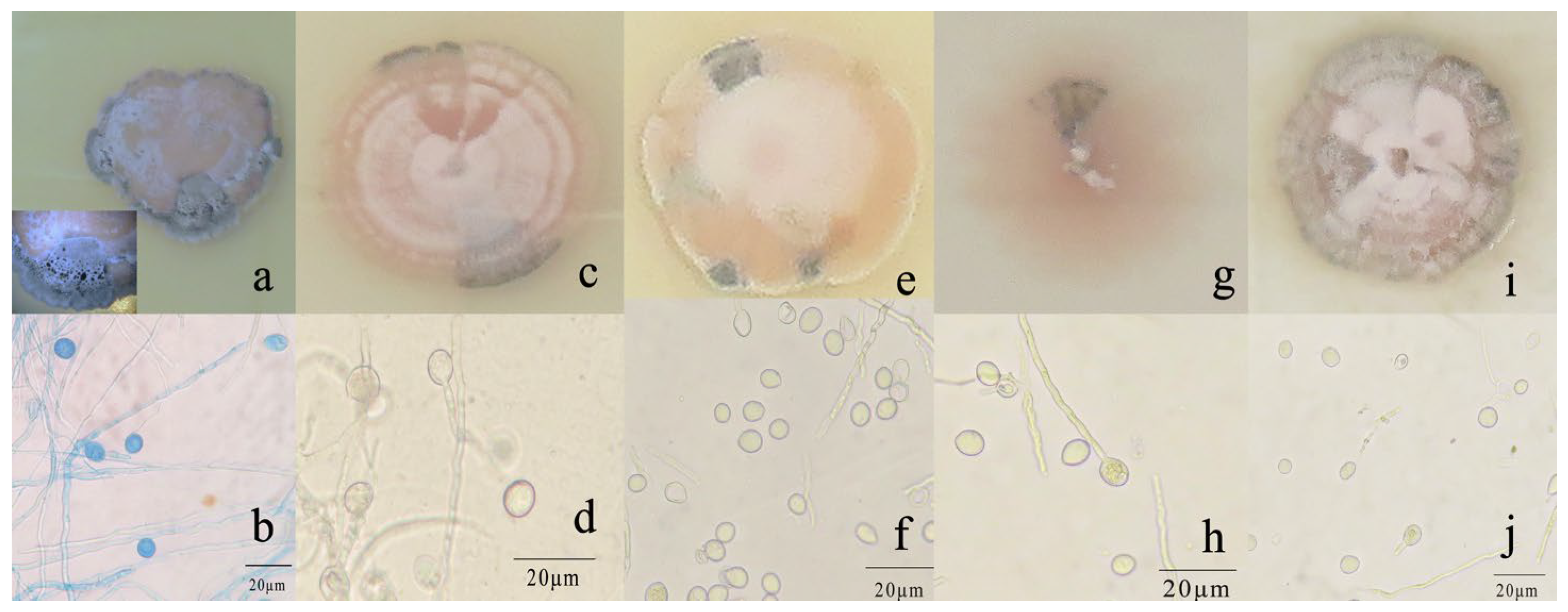


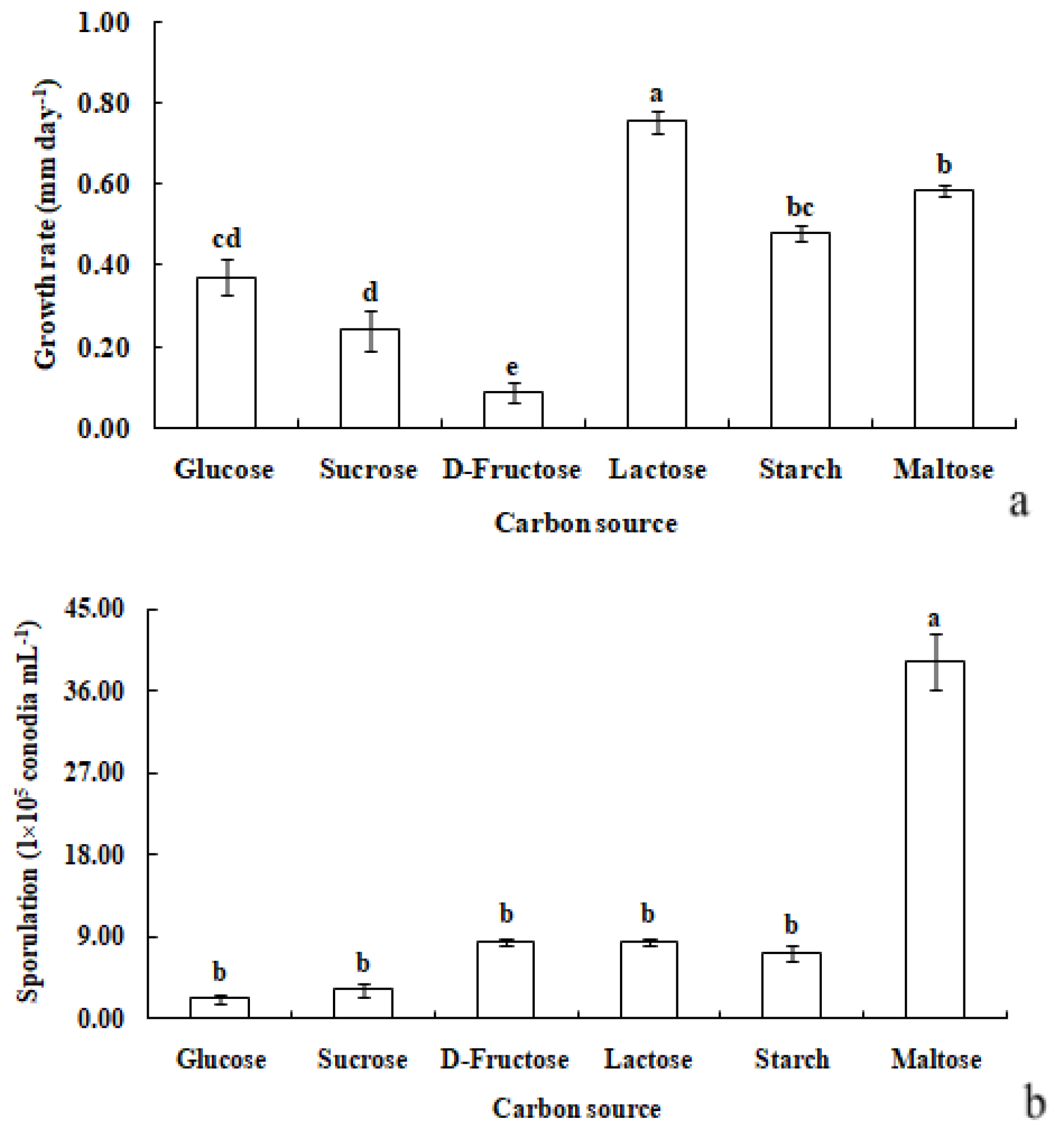

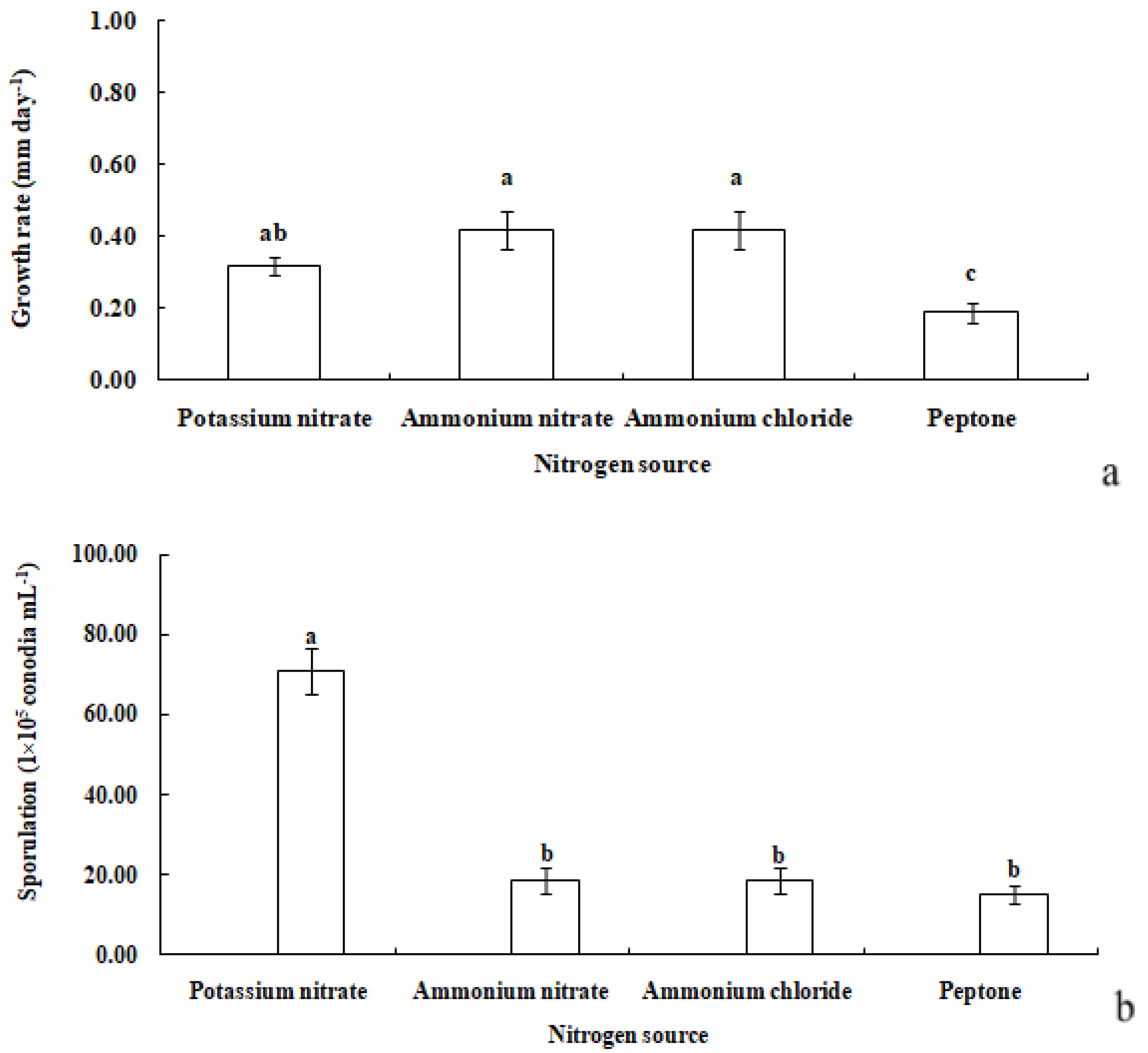


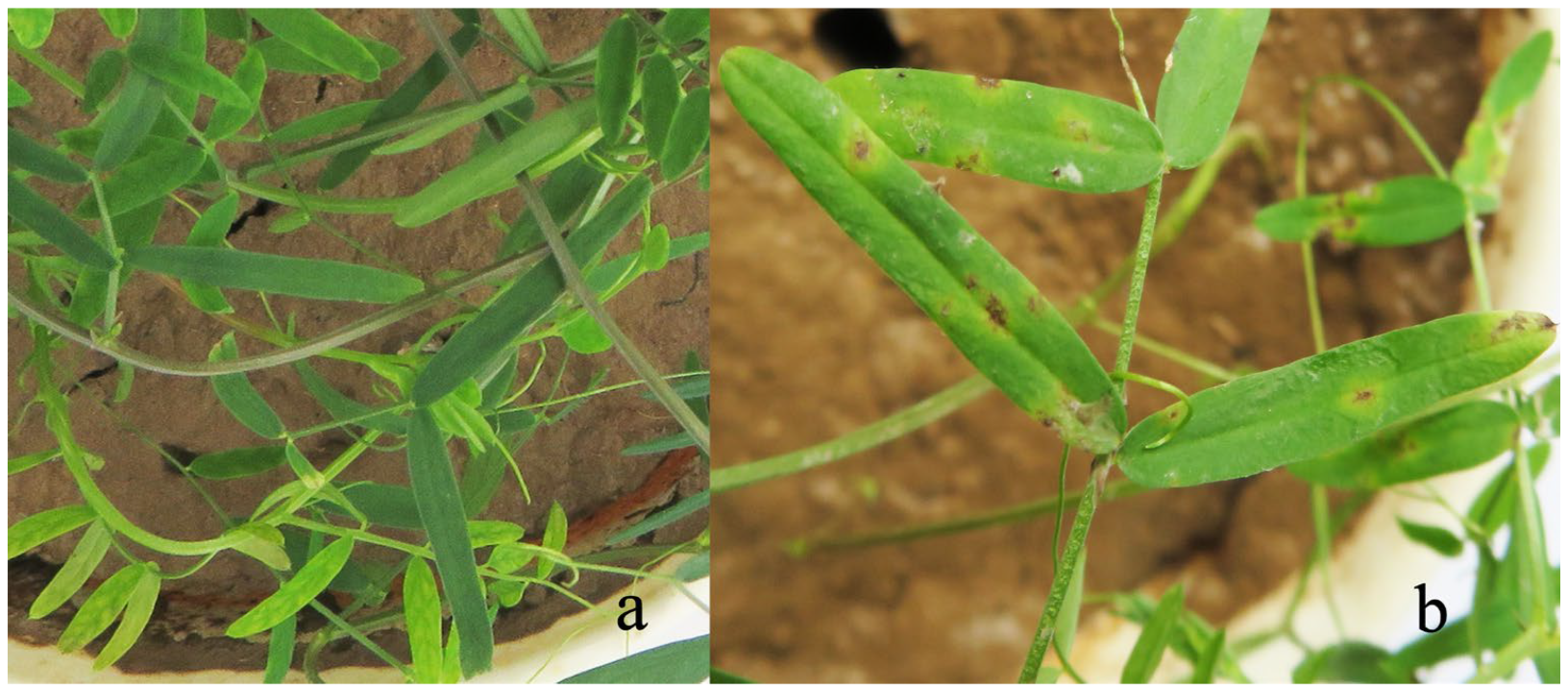
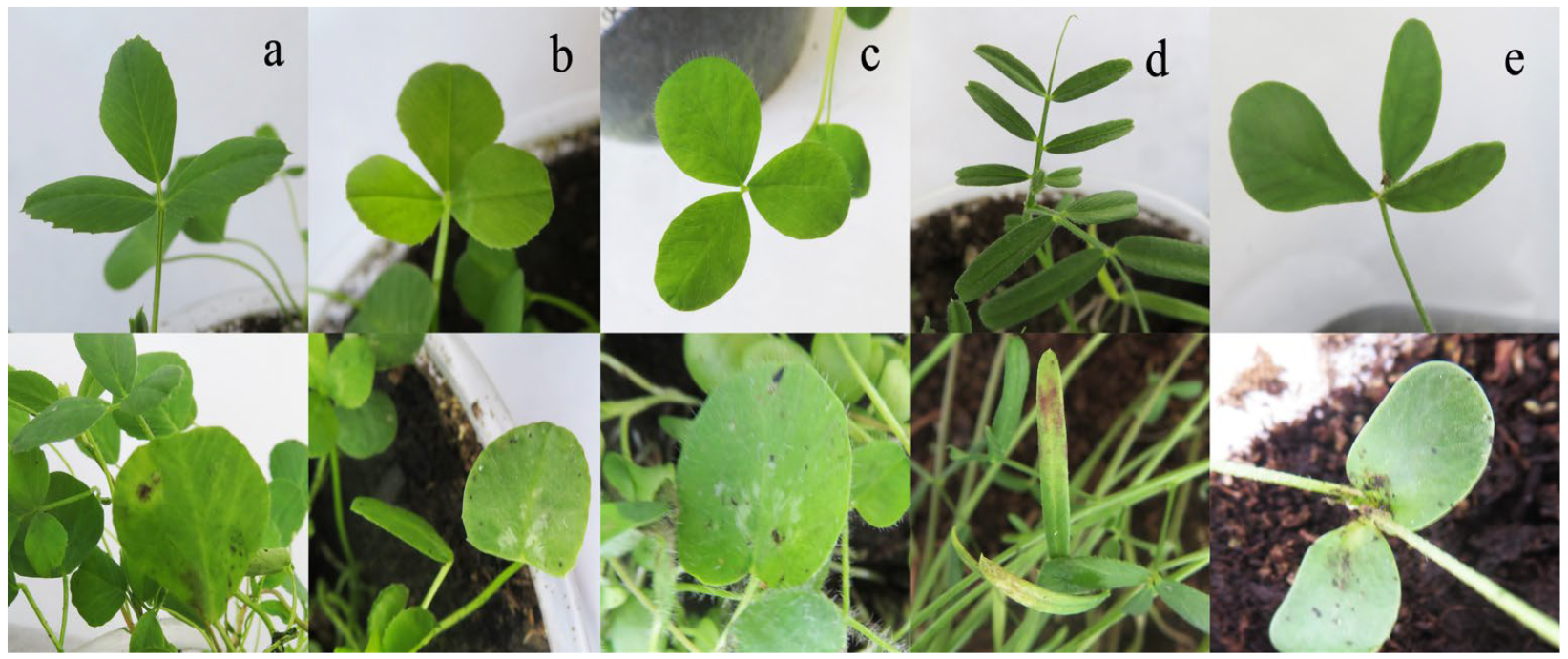
| Colony | Conidia | |||||
|---|---|---|---|---|---|---|
| Diameter (mm) | Morphology | Characteristics | Size (μm) | |||
| Upper | Reverse | |||||
| Media | PDA | 17–20 | white | grey to grey-black | hyaline, spherical, smooth, aseptate | 2.13–3.67 × 4.56–5.77 |
| OMA | 15–16 | white to yellowish | grey | aseptate, ellipsoid to spherical aseptate, spherical | 4.27–6.23 × 4.94–6.59 | |
| LA-PDA | 13–14 | white to pale yellow | white | 5.59–6.19 × 5.94–6.41 | ||
| PCA | 8 | pale pink | pale pink | aseptate, spherical to subglobose | 4.54–6.78 × 5.51–8.61 | |
| CMA | 12 | white | pale yellowish with brown margins | aseptate, spherical | 4.41–6.22 × 5.06–7.21 | |
| Carbon sources | Glucose | 10 | white yellowish | yellow-brown | orbicular-ovate, spherical, | 5.72–6.69 × 4.48–6.89 |
| Maltose | 8.5 | yellowish with no aerial mycelium | yellowish | hyaline, thin-walled, smooth, oval | 5.82–8.50 × 4.53–6.59 | |
| Lactose | 15 | yellow with a white thin edge, black raised | pale yellow with black raised | subglobose | 3.84–6.36 × 3.58–6.60 | |
| Starch | 6 | yellow with black in the center | pale brown | orbicular-ovate | 5.03–6.74 × 4.96–5.87 | |
| D-fructose | 13 | white with yellow, thin | black at the center and pale yellowish | spherical | 7.47–8.58 × 8.6–7.97 | |
| Sucrose | 12 | black at the center with yellowish edges | yellow | spherical | 3.25–5.22 × 3.63–5.13 | |
| Nitrogen sources | Potassium nitrate | 7 | white aerial mycelium, pale pink with a yellow-brown edge on the upper side | Brown-black | spherical | 4.23–7.54 × 5.22–7.24 |
| Ammonium nitrate | 9.5 | pale pink with white aerial mycelium, yellow-brown with black edge | pale brown in the center with a black halo | ellipsoidal to obovoid | 5.45–7.78 × 5.08–7.49 | |
| Peptone | 6.5 | white with pale-brown edge | white | obovoid, spherical | 4.86–7.65 × 5.86–7.16 | |
| Ammonium chloride | 11 | pink with a pale-yellow edge, no aerial mycelium | pale brown in the center with a pale pink halo | spherical | 4.23–7.64 × 4.39–7.74 | |
| Fungicides | Regression Equation | Correlation Coefficient | EC50(mg/L) |
|---|---|---|---|
| Chlorothalonil 75% | y = 0.0201x + 0.5688 | 0.8131 | 2743.42 |
| Mancozeb 80% | y = 0.017x + 0.748 | 0.9434 | 624.72 |
| Difenoconazole 10% | y = 0.006x + 1.4135 | 0.8696 | 319.54 |
| Pentazole alcohol 50% | y = 0.0061x + 1.4124 | 0.9951 | 330.95 |
Disclaimer/Publisher’s Note: The statements, opinions and data contained in all publications are solely those of the individual author(s) and contributor(s) and not of MDPI and/or the editor(s). MDPI and/or the editor(s) disclaim responsibility for any injury to people or property resulting from any ideas, methods, instructions or products referred to in the content. |
© 2024 by the authors. Licensee MDPI, Basel, Switzerland. This article is an open access article distributed under the terms and conditions of the Creative Commons Attribution (CC BY) license (https://creativecommons.org/licenses/by/4.0/).
Share and Cite
Shi, M.; Li, Y.-Z. Evaluation of the Growth, Sporulation, Fungicide Efficacy, and Host Range of Ramularia sphaeroidea. Microorganisms 2024, 12, 766. https://doi.org/10.3390/microorganisms12040766
Shi M, Li Y-Z. Evaluation of the Growth, Sporulation, Fungicide Efficacy, and Host Range of Ramularia sphaeroidea. Microorganisms. 2024; 12(4):766. https://doi.org/10.3390/microorganisms12040766
Chicago/Turabian StyleShi, Min, and Yan-Zhong Li. 2024. "Evaluation of the Growth, Sporulation, Fungicide Efficacy, and Host Range of Ramularia sphaeroidea" Microorganisms 12, no. 4: 766. https://doi.org/10.3390/microorganisms12040766





